The Sounds of a Generation Reflected in the Stars
The Astrology of the Beatles Iconic Rooftop Concert
The 1960s
The Beatles were a rock and roll band that came out of the club scene in Liverpool, England during the early 1960s. Their music helped to define and transform an era marked by political unrest and changing norms related to race, gender equality, drug use, and sex. The Beatles, also known as the Fab Four, were comprised of John, Paul, George, and Ringo. John and Paul were the leaders of the band.
When it came to their cultural impact, outside of the sphere of popular music, John and George were the most influential. George led the band to India for an exploration of Indian music and Eastern spiritual traditions while John became a lightning rod for the growing anti-war and feminist movements. John, with his wife Yoko Ono, combined publicity stunts with public protest. Events like their bed-in for peace staged during their honeymoon used performance art concepts contributed by Yoko that invited the media into their bed along with world famous guests resulting in headline news reported around the world. This event left little doubt that John considered Yoko to be his equal in every way. More evidence of John’s egalitarian views regarding the sexes was seen, quite literally, when the two posed nude for the album cover of Two Virgins (1968). This was a work of experimental music that the two recorded together over a single night before consummating their relationship in the early morning hours. The nude photos set an early precedent for the censorship of album artwork.
Paul and Ringo, by contrast, lived more within the limits posed by the socially accepted norms of the time. They preferred to not become embroiled in hot button issues and did not appreciate it when they were forced to answer for John’s outlandish activities that they had nothing to do with. The Beatles were, however, ultimately known for their music and chart topping hits that dominated the charts for most of the decade. Their music continues to be popular and influential. Today, more than 50 years later, they are still considered to be one of the most influential bands in history.
The Beatles Live Performances
From 1962-1966 the Beatles performed at venues the world over. Playing over 1400 live performances they somehow found time to release seven studio albums. All of this non-stop activity took its toll, and the Beatles became weary of playing live. The final straw came in St. Louis where, like most of their performances, they played outdoors for a stadium packed full of fans. This time though it had been raining before they came on stage. As a result of the wet conditions they were subjected to shocks and nearly electrocuted. Adding insult to injury was their escape from the arena. They jumped into the back of a chrome plated truck, and when it barreled off they were tossed around like four helpless rag dolls. They had finally had enough of exhausting publicity events and the frenetic scenes caused by their live performances. They officially quit the live music circuit for good playing their last show in San Francisco on August 29th, 1966.
Two Air Signs
The Beatles all grew up in the port city of Liverpool. In addition to leading the band, John and Paul were the main songwriters. Both men had their Sun in an air sign. John was a Libra and Paul a Gemini. Both John and Paul lost their mothers when they were just teenagers.
John’s mother Julia taught him to play the ukulele and banjo; she also bought him his first guitar. Julia was hit and killed by a car while walking home in the late hours of the day; she was only 44 years old. John was 17 and living with his Aunt Mimi. John’s parents had divorced, and though Julia had remarried, it was decided that John should live with Mimi, Julia’s sister. After Julia’s death, Mimi and her husband continued to raise John. Aunt Mimi remained a strong maternal force throughout his life; John would call her every week until his death in 1980.
Paul McCartney’s father was a semi-professional musician who played trumpet and piano. He was the leader of a jazz band in the 1920s, and Paul grew up learning show-tune standards. Paul’s mother, Mary, made good money working as a midwife. She rode her bike over hilly terrain and down country roads when she went to work visiting patients. Paul once recounted a time he remembered when his mother was called for a late night maternity visit. He described watching her riding off into the icy winter night to care for an expectant mother. Mary died at the age of 47 due to an embolism she suffered while undergoing breast cancer surgery. Paul was 14 at the time.
Two Water Signs
While George and Ringo may not have been the leaders of the band they were still integral to the foursome’s success. They both contributed songs, vocals, and their own unique musical talent that blended together perfectly forming the Beatles highly infectious chart topping music. Being in the second tier of talent, it was perhaps inevitable that George and Ringo would be born under one of the more passive and feminine Sun signs of the zodiac, one of the signs more adept at playing the role of collaborator rather than leader.
Ringo was born on July 7, 1940 with his Sun in the sign of Cancer. When Ringo was six years old his appendix broke and he developed peritonitis. He nearly perished, and he was left hospitalized for the better part of a year. When he was thirteen he developed tuberculosis, a devastating disease that often killed and left many more crippled. As a result, Ringo spent two years in a sanatorium where he received little schooling outside of some recreational activities that were provided. They taught him how to knit and make pot holders. One day a new teacher came and taught him how to play drums. Bedridden and bored he practiced incessantly whiling away the many months improvising on bed rails and walls. Fortunately for Ringo, and the rest of the world, a new drug called streptomycin had just been developed; it had proven effective in the treatment and cure of tuberculosis. It wasn’t long before Ringo was allowed to return home.
George was known as the quiet Beatle. He was the youngest of four children and the youngest of the “Fab-Four”. His Sun sign is Pisces; he was born close to midnight on the 24th going into the 25th of February. Due to not knowing the precise time of his birth, his birth date is in dispute. George grew up in a council house in an Irish Catholic neighborhood. While all the Beatles came from working class roots, George’s working class background was the most hardscrabble of the lot. His father worked as a bus driver, and his mother was a shop assistant.
Jumpin’ Jack Flash
Unlike the Rolling Stones’ lead singer and front-man, Mick Jagger, none of the Beatles were of the showy extravagant type. Mick was the original Jumpin’ Jack Flash; when he took the stage, he was a wonder to behold. Even when watched on a small TV screen, Mick could command an audience like few others. With unceasing energy and electricity exuding from his every pore, he prowled the stage with the royal preening radiance that only a great Leo presence could ever achieve. The Rolling Stones, now into their 80s, continue to tour the world over.
When the Beatles quit touring in 1966 they barely looked back. Instead, they secluded themselves from the public and produced three massively successful studio albums that maintained their dominance over the pop music charts. Even without a live tour, they were still able to maintain their music’s unequaled commercial success. They were, however, at the behest of Paul contemplating one last live performance, but many questions remained unanswered. Where would they play? What would they play? Would it be broadcast? Once these questions were answered they would have to determine who they could trust to manage the multitude of detail surrounding an historic event of such great scale and importance.
The Get Back Sessions
As part of their ongoing deliberations and practice sessions, the Beatles began reviving and revisiting the standards they used to play live in their early days back in Hamburg, Germany. They knew that a new album of roots based rock music would allow for the spontaneity and ensemble work that was largely missing from their music since they had stopped touring. The new songs would come from the Beatles working together once again as a band rather than as individuals developing their own ideas independently. Since they had quit playing live, their music had come to rely heavily on studio production techniques such as multi-track recording and overdubbing. This next album would not be relying on pioneering innovations or studio tricks.
It had also been decided that all of their work would be documented on film and become part of a TV special that would feature a live performance. With all of this in mind, the Get Back sessions began on January 2nd, 1969 at Twickenham movie studios where they had been offered studio space for the first few weeks of January. They now had a little over two weeks to write, rehearse, and prepare fourteen new songs for two live performances on January 19th and 20th.
The Beatles were famous for working on tight schedules, but this schedule was unusually harsh even for their renowned sensibilities. By the second week of the recording sessions George was becoming increasingly agitated by Paul’s frequent criticism of his guitar work. George already felt he was under appreciated and questioned whether any of his songs were being seriously considered for the new project. The working conditions at Twickenham were already substandard and recent events were causing the situation to further deteriorate. By the end of the week, George walked out of the recording sessions and said he was quitting the band. George eventually returned to finish the project but only after several meetings where it was decided that they would move the entire project to the Beatles’ unfinished Apple recording studios located in the basement of Apple headquarters at 3 Savile Row in central London. They would also abandon the television special, but a live performance was still planned.
A Breath of Fresh Air
On January 19th, George Harrison and Eric Clapton went to see Billy Preston open for Ray Charles. George knew Billy from the Hamburg days when Billy played in Little Richard’s band. George invited him to visit Apple studios, and Billy came the following day. The Beatles needed a keyboard player and invited Billy to sit in on the recording sessions. George Martin, the Beatles producer, wasted no time integrating him into the band. Billy’s electric keyboard playing brought a whole new energy to the mix of the Beatles sound and helped immeasurably to tie the disparate elements of the songs together. With Billy Preston as a guest in their studios, the Beatles were now on their best behavior, and they became charged with renewed inspiration. Billy’s personality and keyboard playing catalyzed the Beatles sound and brought a desperately needed breath of fresh air to the sessions that had grown increasingly stale and acrimonious.
Wait, What did Ringo say?
While debating how to wrap up their documentary film, Ringo mentioned the rooftop space and the owner’s plans to install a garden. John said “we should go up and look at this roof” (Spitz, 2005). After taking in the rooftop, they realized it provided the answers to all of their problems. It was decided they would finish up the project with a live concert on the roof. It would be a live show without all of the hassles of playing in a large venue. Nobody had ever done it before, and all they had to do was go upstairs, plug in, and play. The rooftop concert was scheduled for the next day. They figured they would start playing around noon and give an impromptu lunchtime performance for the people who worked in the nearby office buildings.
Stars on the Rooftop and Stars in the Sky
On January 30th, they arrived on the roof at approximately 1:00. After completing a short sound check, they began what was to be their final live performance as the Beatles.
The stars in the sky were impressive that day for both their astrological significations and for how they portrayed the astrology of each of the Beatles. Of the ten planets in the sky, four were in water signs and four in air signs. This even split between air and water signs in the sky reflected the Beatles with their equal numbers of Sun signs, two in air and two in water. The placement of the planets in the event chart provide for uncanny descriptions of what was happening in the Beatles’ lives around this time.
Gemini is on the ascendant representing Paul, the leader of the band. Paul’s natal chart has a Sun/Mercury/Saturn/Uranus stellium in Gemini that straddles the Midheaven.
Looking at the planets in water signs, the Moon is in Cancer the sign of its domicile. Located on the 2nd house cusp, of supporters and assistance from others, we can see Ringo (Sun-Cancer) providing support and rhythmic structure to the Beatles’ compositions with his understated playing and steady hand.
Next is Mars in his domicile of Scorpio located in the 6th house of being unappreciated; here is George (Sun-Pisces/Moon-Scorpio) grudgingly playing third fiddle to John and Paul the impenetrable stars of the show. Mars, in his domicile, is all revved up and ready to go but is stuck in a house where his full potential goes unrecognized. Neptune, the modern ruler of Pisces, is also in the 6th house; he is in the final degrees of Scorpio and looking forward to the change that is soon to come.
Next is Venus in Pisces the sign of her exaltation. Placed in the 11th house of friends and good fortune we find a brighter side of George (Sun/Venus-Pisces). Here he shares in the limelight as a member of the Beatles working at the peak of their powers. Venus in a close trine to Neptune brings “mystical sensuality and redemption” (Butler, 2018). Behind the scenes, George has been writing the many songs that will become his first solo release, triple album, and magnum opus All Things Must Pass (1970).
Turning to the planets in air signs, Jupiter in Libra represents John (Sun-Libra) located in the 5th house of artistic pursuits. Jupiter forms a loving trine aspect to Mercury; this shows John and Paul reconciled and working together once again. Uranus closely conjunct Jupiter contributes electricity and unexpected dramatic shifts.
The Sun in Aquarius represents another side of John (Sun-Libra/Moon-Aquarius). Aquarius is the sign of the Sun’s detriment; this is descriptive of John’s current battle with heroin addiction. The Sun well aspected in the 10th house indicates professional success. This is supported by the Sun’s close trine to both the ascendant and to Jupiter. While the Sun may be in detriment it is, nonetheless, prominently located and otherwise unafflicted in the chart.
Mercury, the chart ruler, shows Paul prominently placed in the 10th House of profession and prestige. While Mercury is strong in Gemini, he is strongest when he is in his other domicile of Virgo. Mercury requires the stabilizing influence of an earth sign to be most effective. Virgo is also the sign of Mercury’s exaltation. Mercury is the only planet that has their domicile and exaltation in the same sign.
In my personal experience, I have found that when someone has Mercury in Virgo they often possess strong intuitive abilities and events can seem to magically coalesce around them. Billy Preston has a Venus/Sun/Mercury stellium in Virgo. In the January 30th event chart (below), Mercury in the Midheaven represents Billy Preston showing up just in time to make the rooftop concert a resounding success. Paul and Billy together give a representation of both the masculine and feminine sides of Mercury’s dualistic nature.
Saturn, the planet of barriers, is in Aries the sign of its fall. Saturn located in the 12th house of confinement provides a striking visual of the Beatles secluded away, out of sight, and high up on a rooftop where they could “fall”.
The Sun and Saturn form a friendly sextile relationship to each other; Saturn is in the Sun’s sign of exaltation, and the Sun is in the sign of Saturn’s domicile. The two planets meet all of the requirements for mutual reception. When two planets are in mutual reception they are like visitors in each others’ homes who are granted special access to a zodiac sign where they most flourish. In this case, the mutual reception provides beneficence and dignity to Saturn who is ruling the 10th house, the most important house in the chart. The Sun ruling the 5th house of artistic pursuits also benefits through his access to Aries. This mutual reception makes an already impressive chart rather extraordinary.
Further Considerations: Gender in Astrology
Astrology assigns gender to each of the planets and the zodiac signs that describe them. While the Sun (Leo) is masculine and the Moon (Cancer) is feminine, the other five traditional planets have both a masculine and a feminine domicile where they can best express their strengths. An example of this would be Mars with his two domiciles of Aries and Scorpio. When Mars, the warrior planet, is in Aries he tends to be actively aggressive when embroiled in a confrontation. Conversely, when Mars is in Scorpio he is more prone to take his time, hiding out of sight, waiting for an opportune moment to strike. These zodiacal gender potentials exert their influence regardless of the gender of the person they belong to.
Looking at the gender of the seven traditional planets in each of the Beatles natal charts provides some interesting insights. The outer three planets are not considered because their motion is too slow; they are more descriptive of generational differences.
Paul and Ringo have the most planets in masculine signs with 5 and 4 respectively; John and George have the fewest with 3 and 2 respectively. Looking at the planets in feminine signs we find the mirror image. George and John have 5 and 4 respectively while Ringo and Paul have 3 and 2 respectively.
Comparing a list of gender traits to each of the Beatles provides support for the idea that people born with more planets in masculine signs tend to express themselves in a more masculine manner. Paul and Ringo are more likely to display the masculine traits of assertiveness, discipline, independence, focus, autonomy, decisiveness, stability, practicality, and accountability.
On the other hand, George and John can be more readily identified with the feminine traits of openness, softness, radiance, warmth, sensitivity, receptiveness, collaboration, intuition, and empathy.
While the Beatles story provides a compelling case study for evidence of gender tendencies being revealed through their natal astrology it is far from definitive. Gender, like most human characteristics, exists on a continuum that varies over time. The predominance of masculine or feminine signs on a natal chart can be used as a reliable indicator of a native’s tendency to display more or less of one set of gender traits. While those with a more equal balance of masculine and feminine signs will accordingly present with a more even distribution of gender traits.
Conclusion
The Beatles and their music came at a time when strong forces were reshaping Western culture. These forces included women’s rights, civil rights, political assassinations, growing economic prosperity, youth culture, widespread use of psychedelic drugs, and more. The Beatles arrived in America in the wake of president John F. Kennedy’s murder. The traumatized nation and a youth culture looking for escape unraveled as the decade wore on. The Beatles music started to become political as young men were being increasingly drafted into an unpopular war far from home in Vietnam. The Beatles were aligned with the younger generation and their insistence that people regardless of race, gender, or sexuality should be treated with respect and dignity. These were not the accepted norms of the time. The older and more conservative generation was threatened by the rapid changes that were occurring all around them. This resulted in a generational gap that had never before, or since, been so wide. While the parents generation may have thought that all the kids cared about was sex, drugs, and rock and roll; the Beatles’ message was ultimately one of peace, love, and understanding.

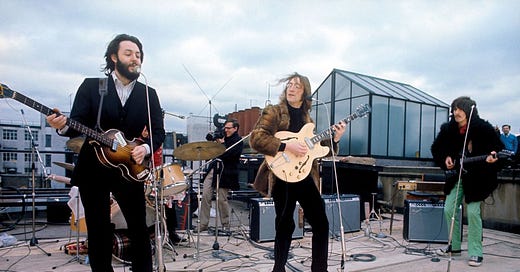



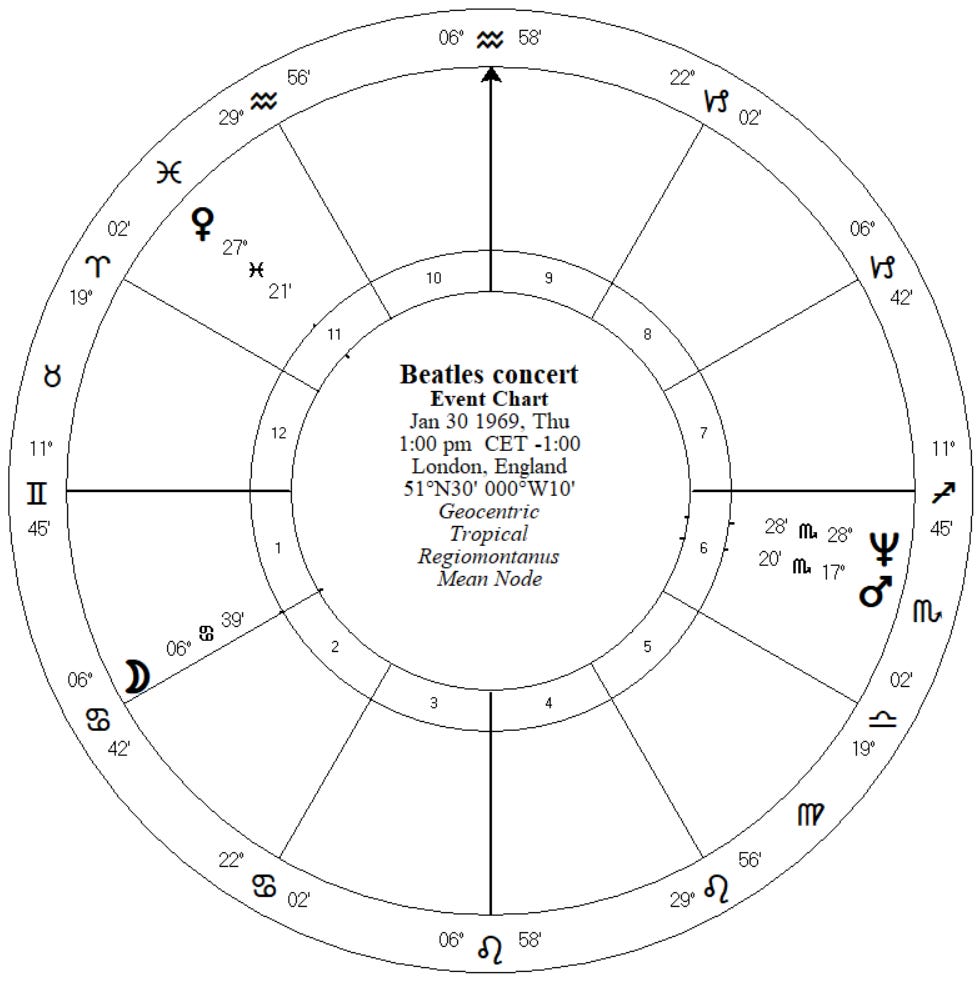
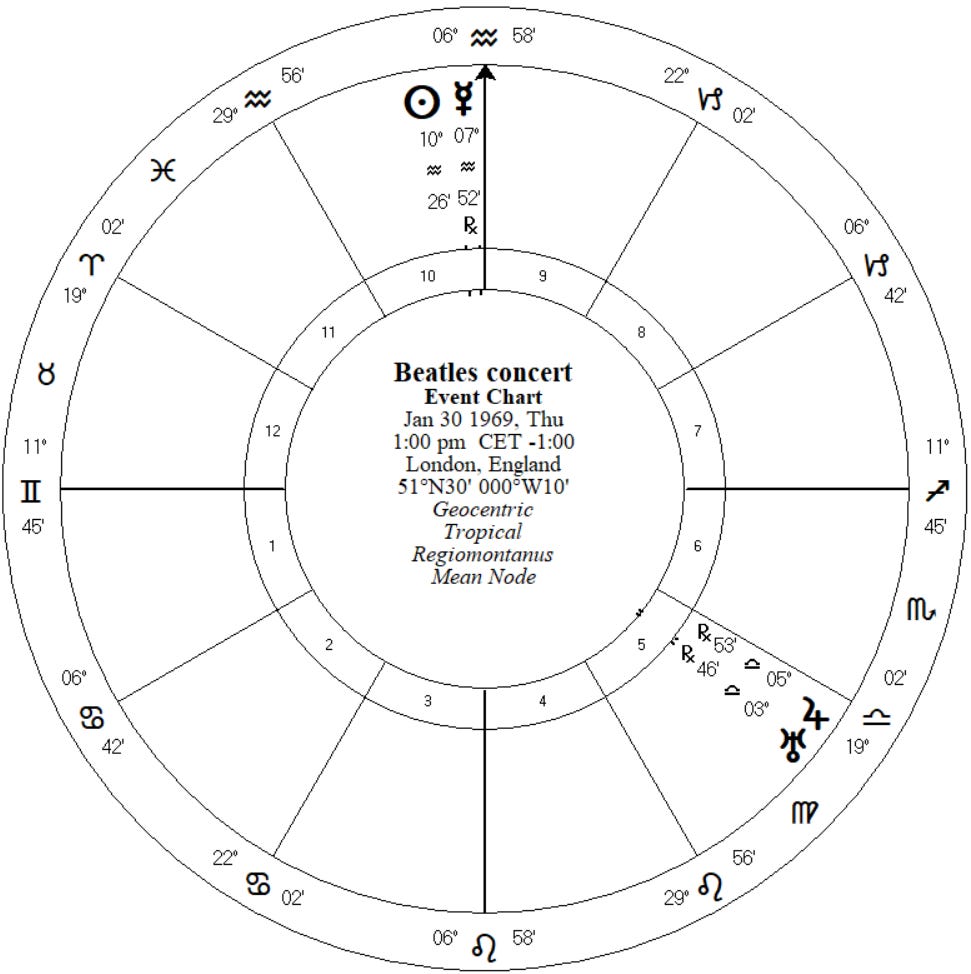
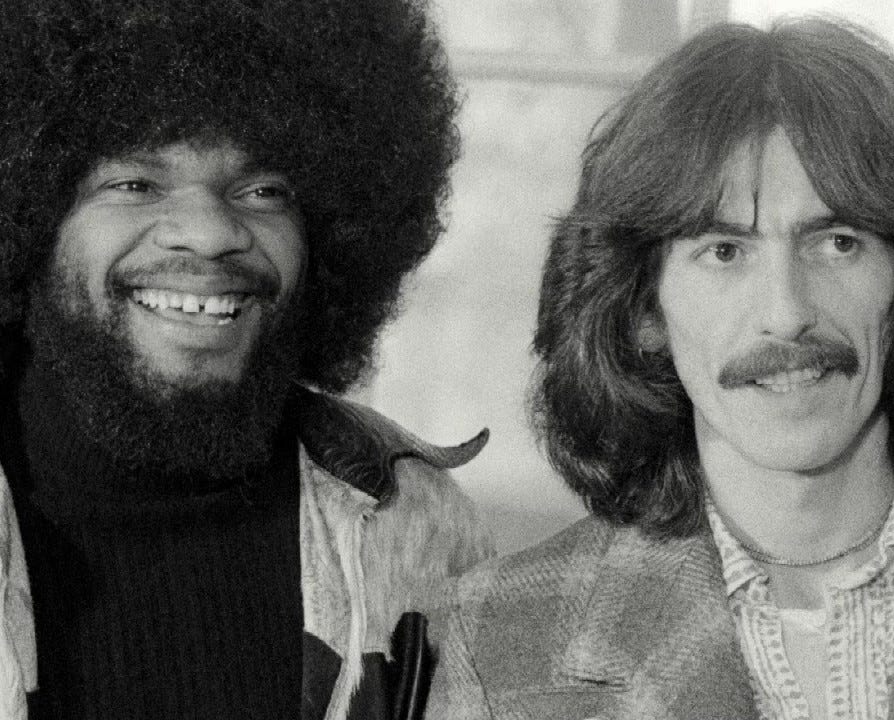
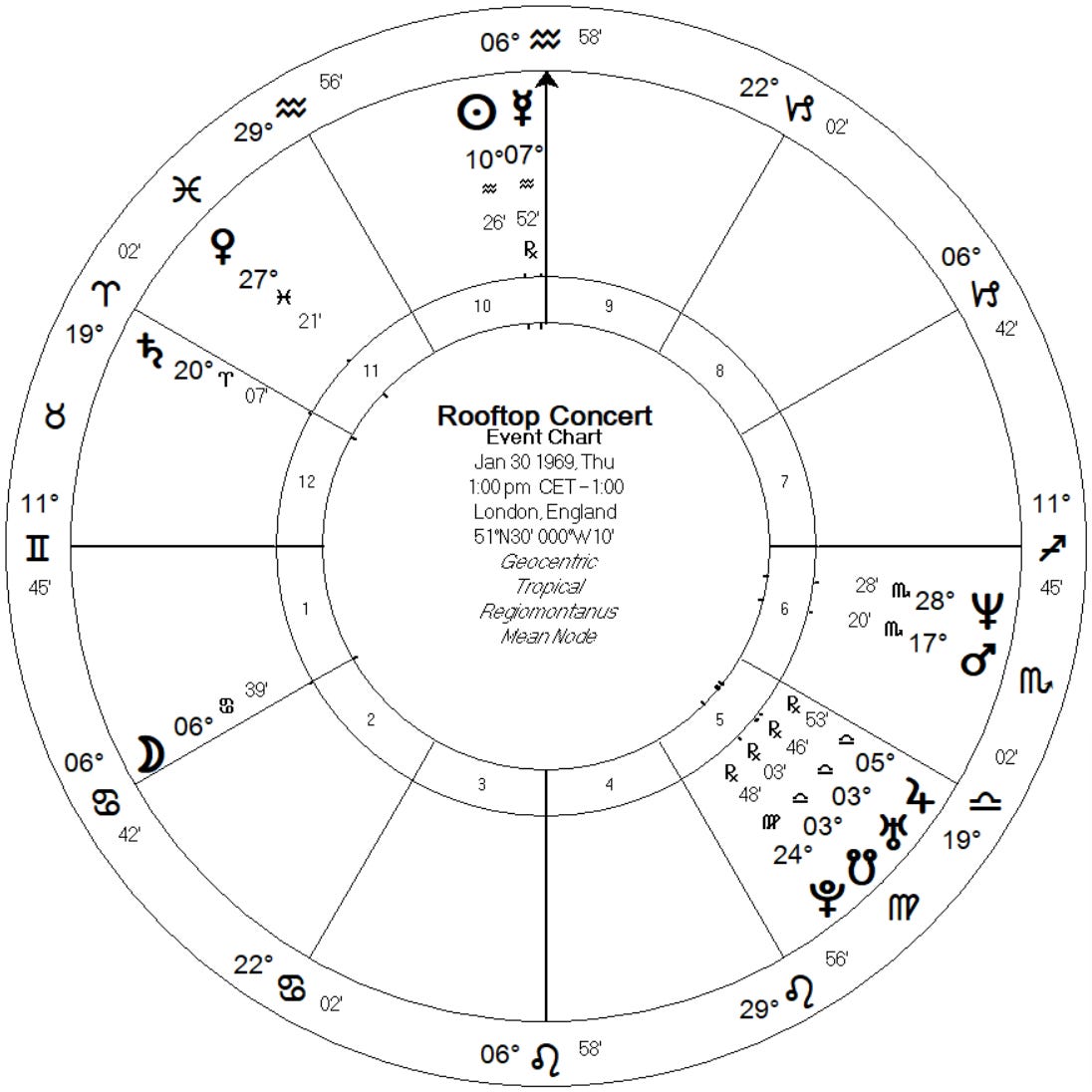
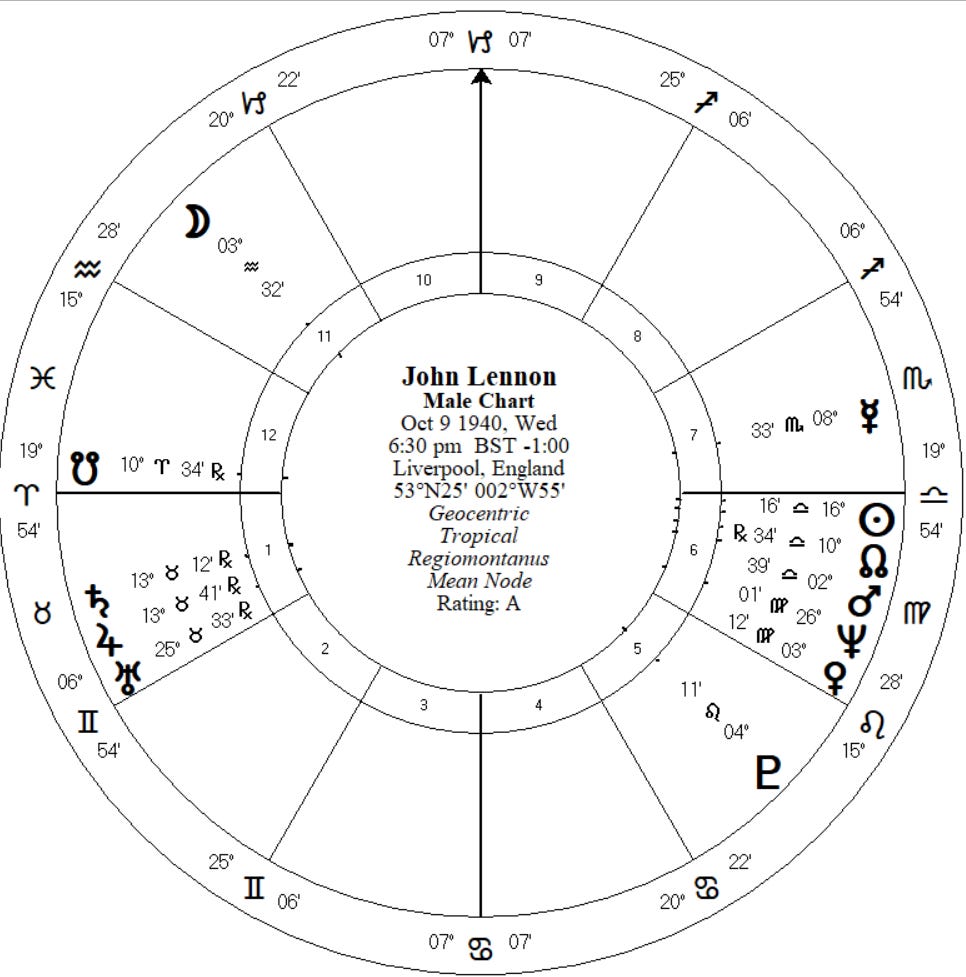
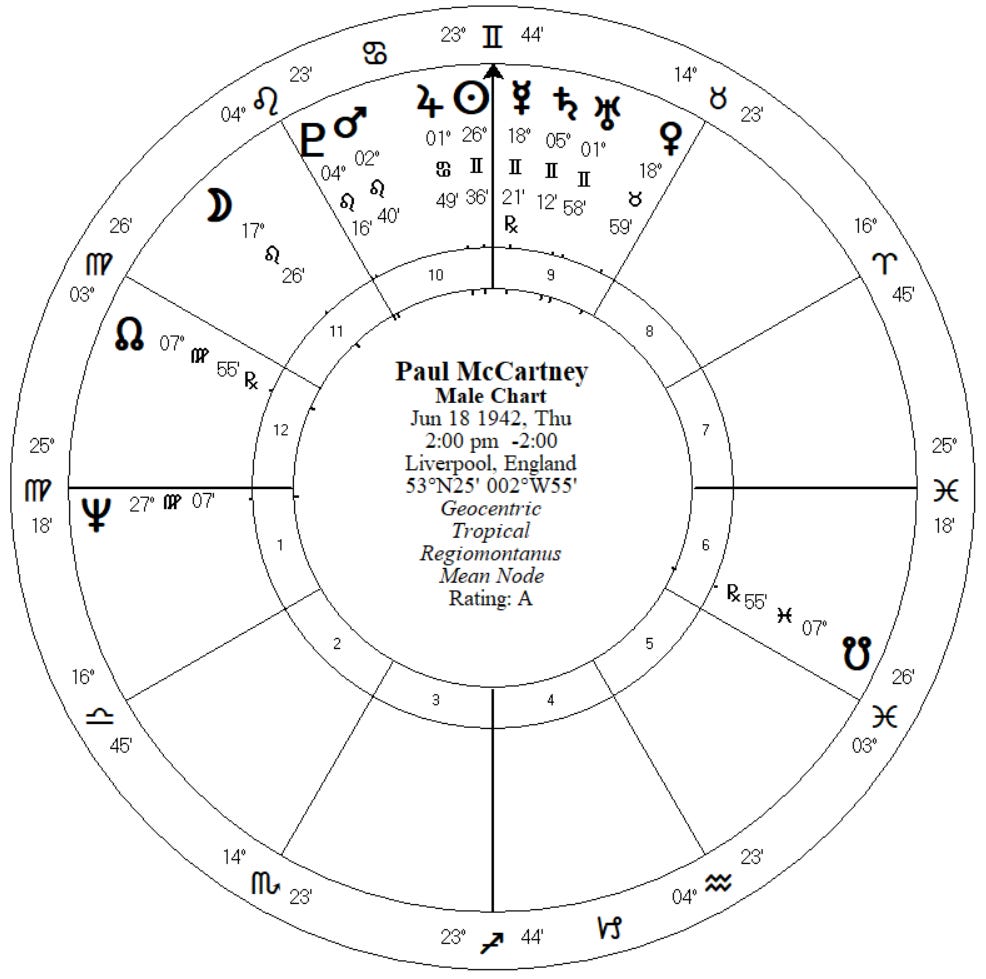
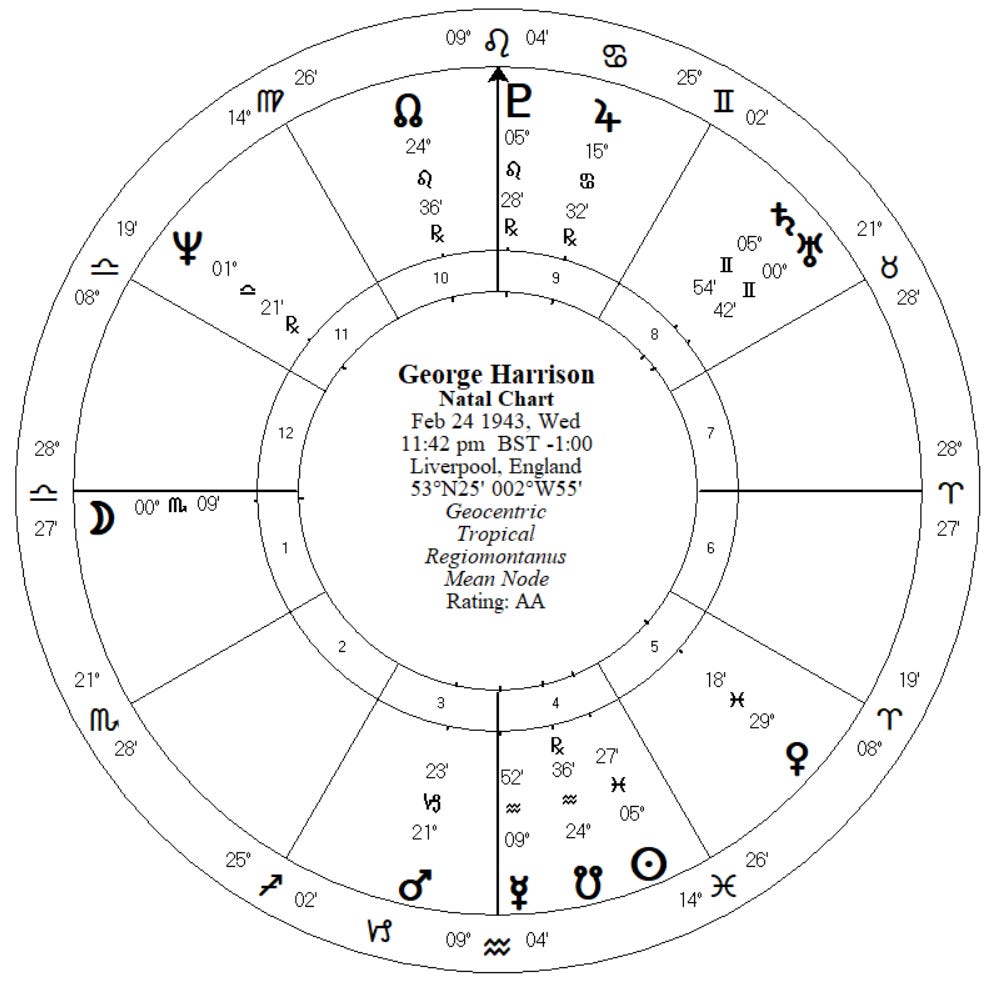
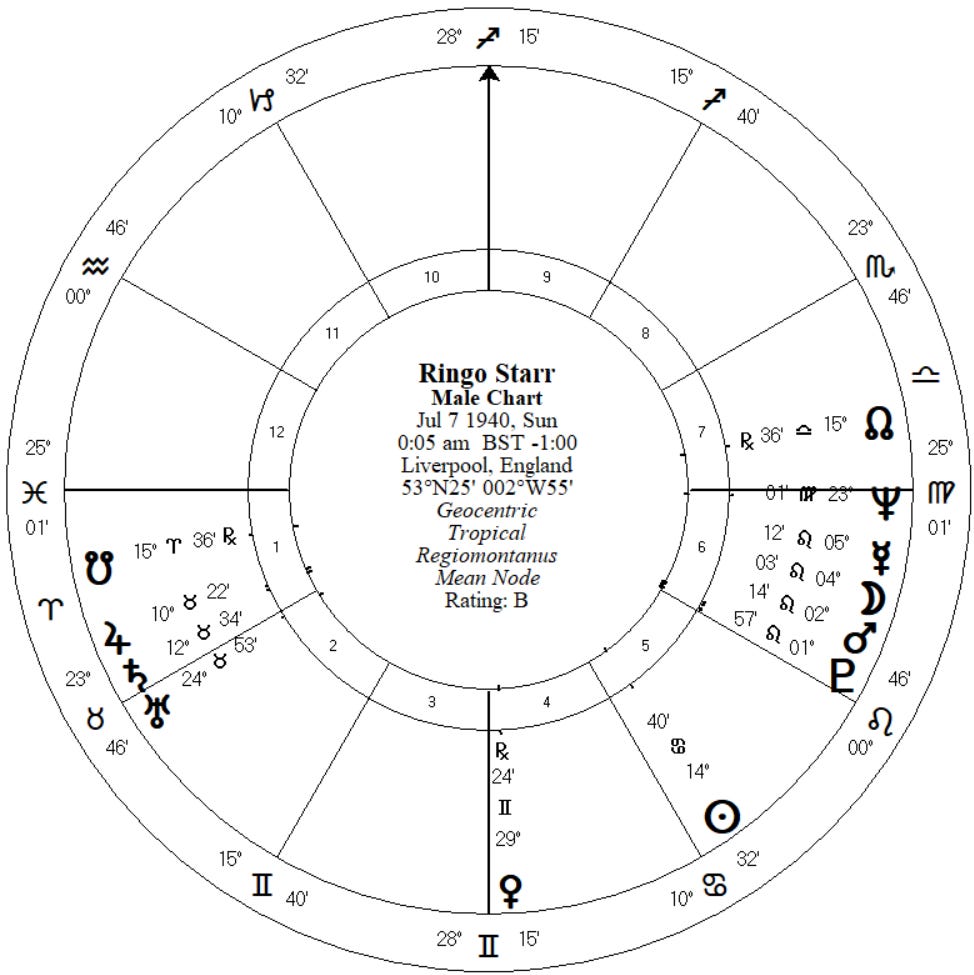
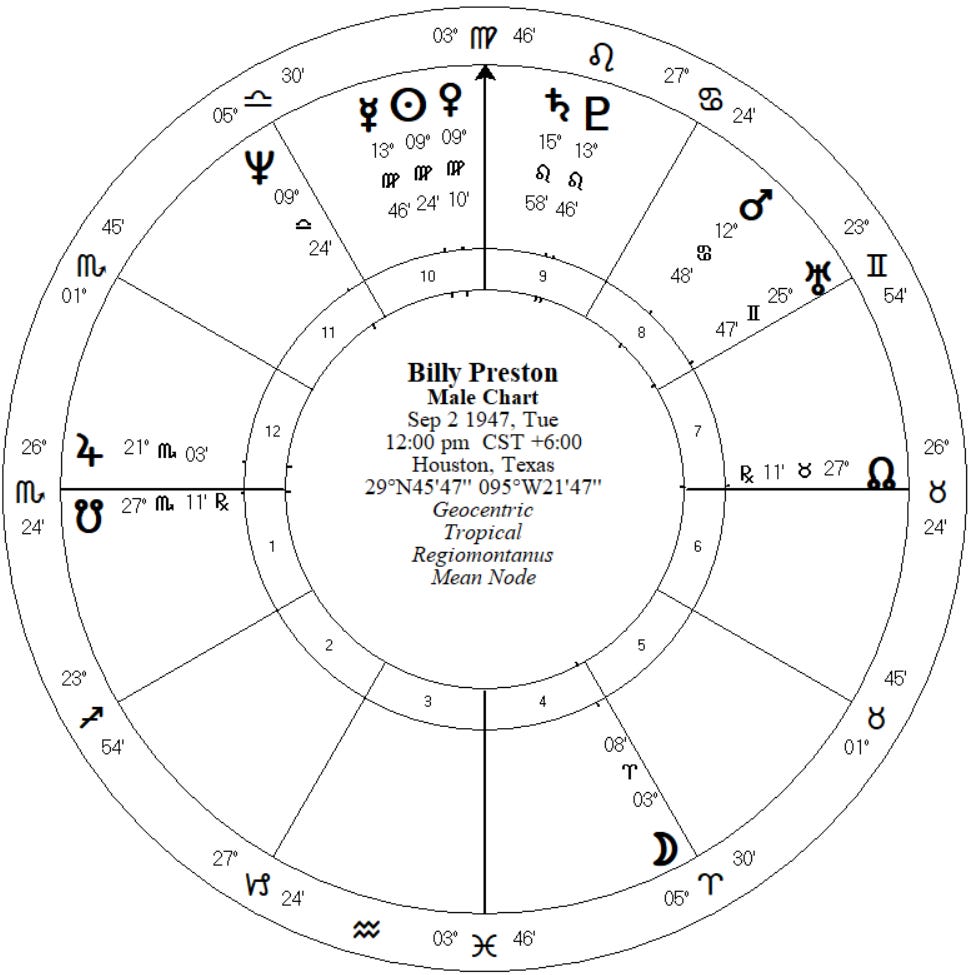

"Located on the 2nd house cusp, of supporters and assistance from others...".
Just the opposite. It is the EIGHTH house which is assistance from others, as the 8th is in the west, begun in the 7th house of marriage and partnerships and relationships in general.
The SECOND house shows one's PERSONAL resources; the EIGHTH house shows one's SOCIAL resources.